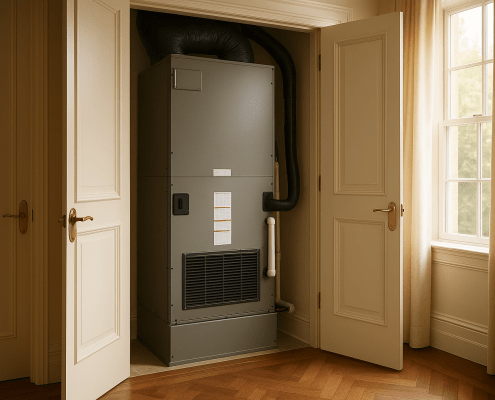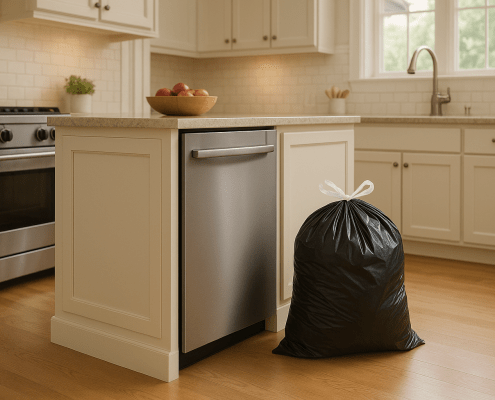How to Get Burnt Smells Out of Your House After a Kitchen Mishap
Steven E / Wednesday April 16, 2025
You turn around for what feels like two seconds, and suddenly your kitchen smells like a barbecue gone horribly wrong. Maybe it was toast, maybe a tray of forgotten cookies, or maybe something you can’t even identify, either way, the aftermath is unmistakable: a burnt smell that refuses to leave.
The good news? You don’t need a professional cleaning crew or fancy air purifiers to fix it. With a little effort and the right steps, you can completely eliminate that lingering burnt odor from your home, all on your own.
We’ll walk you through simple, effective, and affordable methods to get your home smelling fresh again. No panic. No expensive sprays. No calling in the pros. Just results.
Step 1: Get Rid of the Evidence
The longer the burnt item hangs around, the more it stinks up the place. So, your first move is to remove anything that’s charred or smoky from your kitchen.
What to do:
- Toss the burnt food outside, not in the trash can under your sink.
- Take any burnt cookware outside or move it to a closed-off space like a garage.
- Open all your windows and doors to start airing the space out.
- Switch on your range hood fan and ceiling fans if you have them.
This simple first step helps stop the smell from spreading even further through your house.
Step 2: Air It Out Like a Pro
One of the best tools in your burnt-smell-fighting toolbox is good old fresh air. The goal is to push out the stale, smoky air and bring in the good stuff.
Ventilation tips:
- Open windows on opposite ends of the house to create a cross-breeze.
- Place a box fan in one of the windows facing outward to suck the smoky air out.
- Run bathroom exhaust fans, kitchen vents, and any portable fans you have to keep air moving.
Let the air flow for a couple of hours, or longer if the smell is strong. You’ll notice a difference quickly.
Step 3: Deodorize the Air (Don’t Just Cover It Up)
Forget overpowering air fresheners. Instead, focus on neutralizing the smell completely.
Easy and effective odor absorbers:
- White vinegar: Fill several bowls and place them in the kitchen and nearby rooms. Let them sit overnight if possible.
- Baking soda: Set out bowls or sprinkle some over fabric surfaces (like your couch or rugs), let sit for a few hours, then vacuum.
- Coffee grounds: Believe it or not, they absorb smells and add a pleasant aroma.
- Activated charcoal: Great for small, enclosed spaces and absorbs odors fast.
These pantry staples can do serious damage to smoke odors without leaving behind any fake floral fog.
Step 4: Wipe Down Every Surface
Smoke leaves more than just a smell, it also deposits tiny particles on your kitchen’s surfaces, which means the odor can hang around long after the air clears.
Clean these areas thoroughly:
- Walls and ceilings: Wipe with warm water, vinegar, and a few drops of dish soap.
- Counters, cabinets, and backsplash: Use a degreasing cleaner or the same vinegar solution.
- Appliances: Give your stove, microwave, and especially your range hood a deep clean. Don’t forget to clean or swap out the range hood filter.
If the burn happened in the oven, scrub the inside down with a paste made from baking soda and water. Let it sit for a few hours before wiping it clean.
Step 5: Refresh Soft Surfaces
Fabrics and upholstery are like smoke sponges, they absorb odors fast and hold onto them. If your kitchen shares space with a living room or dining area, you’ll want to hit all your soft surfaces too.
What to clean:
- Curtains and fabric blinds: Toss them in the wash with vinegar and laundry detergent.
- Couches, pillows, and chairs: Sprinkle baking soda over surfaces, let sit for a few hours, and vacuum thoroughly.
- Carpets and rugs: Use a steam cleaner if you have one, or treat them with baking soda + vacuum.
For items that can’t be washed, try spritzing with a vinegar-water solution or setting them near a window to air out naturally.
Step 6: Don’t Forget Your Filters
Airborne smoke particles don’t just disappear, they often get pulled into your HVAC filters or air purifiers, where they stay and recirculate unless you do something about it.
- Change or rinse out your HVAC air filter if you have central air.
- Clean any portable air purifiers and replace their filters.
- Wash your range hood filter (if it’s reusable) with hot soapy water and a little degreaser.
A clean filter means cleaner air, and no more recycling burnt smells back into your living space.
What If the Smell Still Lingers?
Sometimes burnt smells are extra stubborn. Here’s what to try next:
- Repeat odor absorbers: Leave fresh bowls of vinegar or baking soda out for another 24 hours. Sometimes it takes more than one round to absorb everything.
- Clean overlooked spots: Think fridge seals, drawer interiors, or under appliances. Smoke can get into weird places.
- Use sunlight: Sunlight helps eliminate odors naturally. If it’s a nice day, let fabrics or rugs hang outside to air out.
- Run the exhaust fan longer: Even after cleaning, letting your exhaust fan or hood vent run for several hours can help pull lingering odor particles out of the air.
Stay In Touch
A burnt smell might feel like it’s taken over your house, but it doesn’t stand a chance against a good game plan. With our tips, you’ve got everything you need to do it yourself, no professionals, no harsh chemicals, and no panic required.
If you need any replacement parts for your appliances, you can enter your model number at AppliancePartsPros.com to locate and order them quickly. Most orders arrive in just two business days, and we have tons of great information in our repair help section and YouTube videos to help you troubleshoot.
Stay connected with the latest DIY tips, tutorial videos, and repair guides by following us on Facebook, Instagram, and Twitter. We love hearing about your repair stories and successes. If you need more help or want personalized guidance, feel free to reach out. We’re ready to help you take on your next project with confidence!
The information in this article may not apply to your specific appliance model. We recommend consulting your manufacturer’s documentation or contact us with any questions.
With nearly a decade of experience in providing top-notch customer service regarding appliance parts and repair, Steven enjoys sharing practical advice, troubleshooting tips, and interesting information to help readers stay informed.





